Part 1
Here are the first 6 of 16 low-cost, effective ways to spruce up your store
if you are not yet ready to do a major showroom renovation.
In this current market environment, the cost of renovating a furniture
showroom can seem off-putting, expensive, and time-consuming. Retailers are
still experiencing construction labor shortage issues along with building
material backlogs. Inflation has added to the price of goods and materials
for construction. For example, seven consecutive quarterly cost increases
for gypsum board for wall construction have raised the price to an average
of $15 per panel. Metal studs cost between $2 and $5 per square foot and are
predicted to increase 31percent in 2023. On top of that, contractors and
mill workers are unavailable for new work. Most have long client waiting
lists for starting new projects.
A Way to Offset Costs
A major store renovation will cost a minimum of $30 per square foot or more.
Many retailers are waiting for prices to drop, hoping to get lower bids from
contractors. However, if you are looking to buy or rent a new space, there
are plenty of deals to be found. Plenty of stores are going out of business
or reducing their real estate inventory. These include major retail brands
such as JCPenney, Macy’s, Sears, Dick’s Sporting Goods, Gap, and Tuesday
Morning. Many of my clients are finding excellent square footage
opportunities in favorable shopping districts.
If you have loyal contractors that can fit you into their schedule, the
benefits of taking over one of these stores can by far offset the costs.
Some of the deals are too good to pass up. Malls and shopping centers that
need a tenant to take over a 30,000 square-foot-space often find that
furniture stores are the only game in town. If you decide to rent such a
space, negotiate with the landlord to deliver it in “white box” condition.
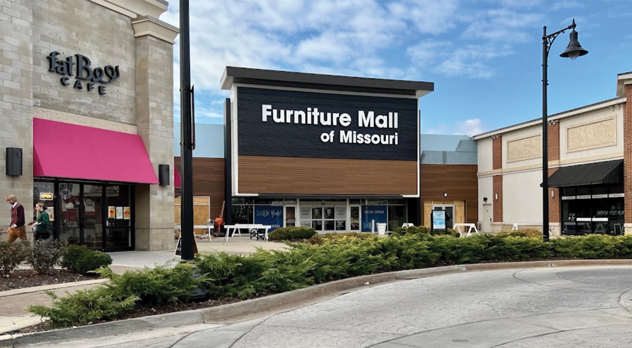 FURNITURE MALL OF MISSOURI: Furniture Mall of
Missouri converted a 125,000-square-foot Macy’s store in Summit
Hill, Missouri—part of a 500,000-square-foot open-air lifestyle
center—into a new showroom after securing a favorable lease.
FURNITURE MALL OF MISSOURI: Furniture Mall of
Missouri converted a 125,000-square-foot Macy’s store in Summit
Hill, Missouri—part of a 500,000-square-foot open-air lifestyle
center—into a new showroom after securing a favorable lease.
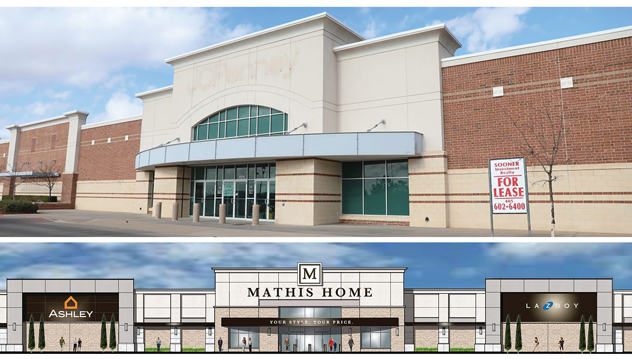 MATHIS HOME: Mathis Home recently took over a
100,000- square-foot JCPenney store in Midwest City, Oklahoma. The
city helped offset renovation costs and will reimburse Mathis based
on future sales. That made the deal attractive for a building that
would have been difficult to lease otherwise. (Photo credit:
exterior rendering by RBA Architects, OKC)
MATHIS HOME: Mathis Home recently took over a
100,000- square-foot JCPenney store in Midwest City, Oklahoma. The
city helped offset renovation costs and will reimburse Mathis based
on future sales. That made the deal attractive for a building that
would have been difficult to lease otherwise. (Photo credit:
exterior rendering by RBA Architects, OKC)
Interiors Home, for example, negotiated a lease on a vacant H. H. Gregg
space in York, Pennsylvania. It was delivered to them as a white box ready
for build-out. They used the landlord’s architect and contractor to build
out the space more effectively. Steger’s Furniture took over an Ashley Home
store in Peoria, Illinois, which had suffered extensive water damage from a
pipe break. They negotiated an attractive deal, building the space out
smartly with a design-build approach using existing contractor
relationships.
“A major renovation will cost you a minimum of $30 per square foot or more.
Many retailers are waiting for prices to drop, hoping to get lower bids from
contractors.”
If you cannot find one of these great deals in your market or are not
looking to expand into new markets, here are some ideas that will allow you
to refresh and upgrade your store with minimal investment.
-
Rearrange Departments in Store. If you’ve been meaning
to move departments around, now is the time to make some major shifts.
For one, make sure your upholstery and motion departments are near the
front of your store along with your mattress department. Bedroom
furniture should be located next to mattresses, with bedroom sets placed
along as much of your perimeter wall as possible. Dining is a
destination department, so locate it further from the front door. Place
dining furniture in front of other furniture categories that require
walls for display purposes.
Shifting around departments can increase sales and give your employees a
morale boost. Interiors Home, Lancaster, recently relocated its entire
mattress department to the front right corner of the showroom, lifting
mattress sales immediately. They also reduced their outlet footprint to
make room for a new Stressless presentation. The vendor supplied
large-scale light boxes and digital screens that positively impacted the
space, leading to more sales as well.
-
Re-Purpose Excess Warehouse Space. Furniture retailers
can free up space by identifying underutilized, inefficient areas,
freeing them up for other uses. Those who no longer need all of their
current warehouse, storage and receiving space can add a clearance or
outlet center. Often, it’s not necessary to demolish walls or build new
ones. Just fence off an area using stanchions or a low movable wall
system. Shoppers can see the inner workings of the warehouse environment
while they shop for clearance goods. Warehouse racking can easily be
used to display certain products such as sofas.
“Make sure your upholstery and motion departments are near the front of
your store along with your mattress department. Bedroom furniture should
be located next to mattresses.”
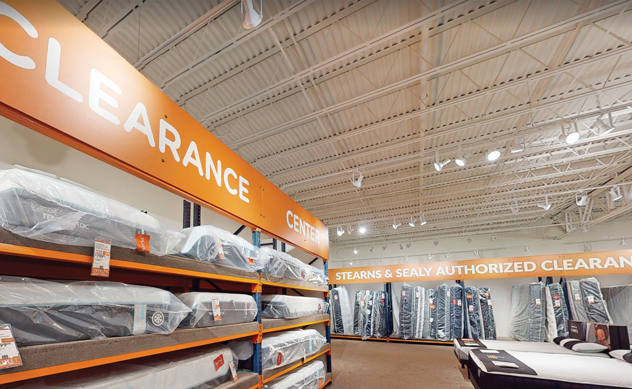 WAREHOUSE SPACE: Move your outlet area into your
warehouse, sectioning it off with just stanchions or a rope to
open up more square footage in your showroom for other
products.
WAREHOUSE SPACE: Move your outlet area into your
warehouse, sectioning it off with just stanchions or a rope to
open up more square footage in your showroom for other
products.
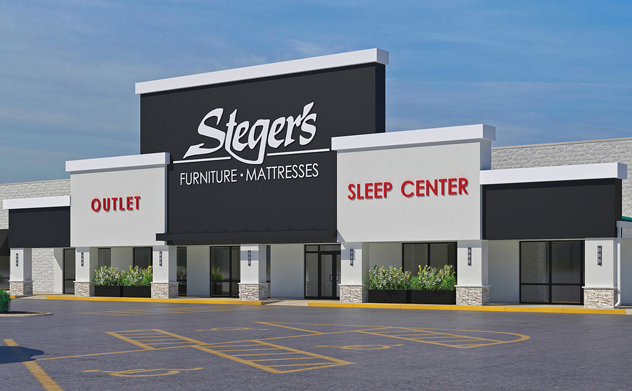 STEGER’S FURNITURE: Steger’s Furniture
negotiated a deal to convert a 50,000-square-foot Ashley Homestore
space in Peoria, Illinois (after it suffered water damage from a
broken pipe) into a new Steger’s store using a design-build
approach that saved them time and money.
STEGER’S FURNITURE: Steger’s Furniture
negotiated a deal to convert a 50,000-square-foot Ashley Homestore
space in Peoria, Illinois (after it suffered water damage from a
broken pipe) into a new Steger’s store using a design-build
approach that saved them time and money.
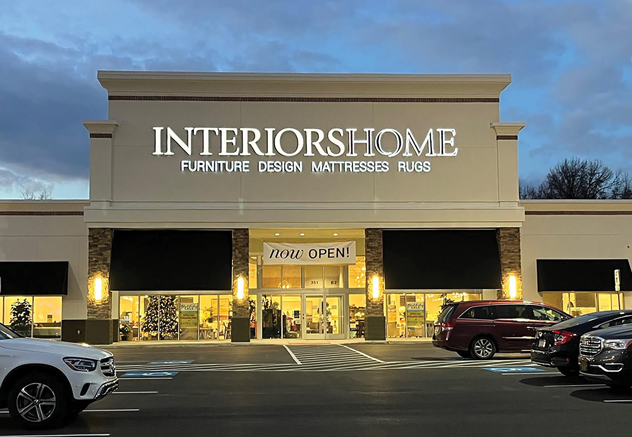 INTERIORS HOME: Interiors Home opened its latest
store in the York, Pennsylvania, market after working out a deal
with the landlord of the Manchester Crossroads shopping center to
deliver a 40,000-square-foot H.H. Gregg electronics store space
that was “white box” ready.
INTERIORS HOME: Interiors Home opened its latest
store in the York, Pennsylvania, market after working out a deal
with the landlord of the Manchester Crossroads shopping center to
deliver a 40,000-square-foot H.H. Gregg electronics store space
that was “white box” ready.
-
Introduce Seasonal Products. Patio furniture is a
profitable seasonal product to add should you have available exterior
space, perhaps on the front or side area of your showroom or even your
warehouse. These areas may be fenced off easily with planters or a
movable picket fence. This furniture may need to be locked down or moved
in and out of your showroom daily. Doing this isn’t much of a burden,
especially if the category is only on display for a few months each
year. These outdoor areas have an additional advantage. They provide
valuable opportunities to host grill-outs, live music events and other
family-friendly, promotable events to draw customers into your store.
-
Bring in a Visual Merchandiser. Now is a great time to
refresh your stores with a new merchandising perspective. Hire a visual
merchandiser to provide fresh ideas, suggest new accessory looks, train
staff, and more. This has the added benefit of re-motivating your
in-house merchandising team and polishing their skills. Retailers who do
this multiple times a year achieve the best results.
-
Create an Accessories or a Marketplace Zone. Carve out
a dedicated area for accessory displays or a larger marketplace display.
This will occupy minimal space and work well next to your customer
service areas. Freestanding shelving units have successfully been used
to create attractive displays in the middle sections of many furniture
stores. Alternatively, they can be placed against a wall for easy
visibility. Purchase accessories specifically for display in this zone
to communicate to customers that you are not only in the business of
selling furniture—you are also in the style business.
-
Add Rugs. If you do not yet have a rug program,
consider adding one. Most rug vendors provide racks to retailers as part
of their program. If space is an issue, smaller racks are available,
often at no cost. Adding rugs to room set displays has many benefits. It
allows customers to visualize how a rug will look in their homes and
makes it easier for salespeople to segue into an add-on sale. Some
retailers successfully enhance their visual merchandising by layering
hanging rugs vertically from ceilings to create dramatic fashion
statements. Doing this attracts attention and can make rug areas feel
like a bazaar.
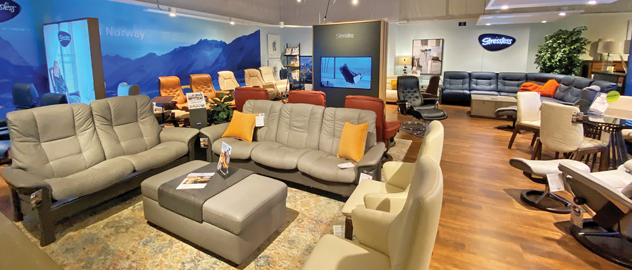 INTERIORS HOME: Interiors Home recently reduced
the outlet space in their Lancaster, Pennsylvania store to make room
for a new Stressless presentation that will lead to higher-margin
sales.
INTERIORS HOME: Interiors Home recently reduced
the outlet space in their Lancaster, Pennsylvania store to make room
for a new Stressless presentation that will lead to higher-margin
sales.
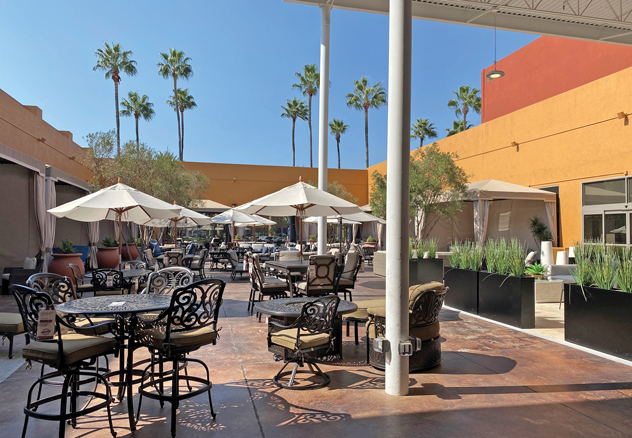 MATHIS HOME: Mathis Home in Irvine, California,
took advantage of an old garden center space (attached to the former
Home Depot they renovated) to create a compelling patio furniture
display.
MATHIS HOME: Mathis Home in Irvine, California,
took advantage of an old garden center space (attached to the former
Home Depot they renovated) to create a compelling patio furniture
display.
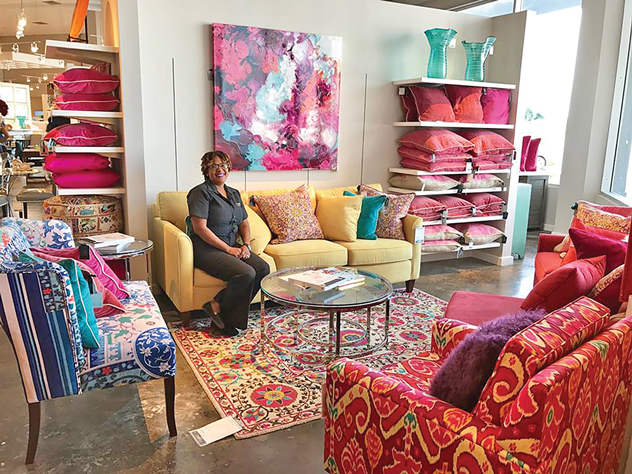 DWELLINGS: Dwellings brings in an outside visual
merchandiser four times a year to refresh their stores, train their
staff and make their stores in Barbados and Trinidad good-looking on
a daily basis.
DWELLINGS: Dwellings brings in an outside visual
merchandiser four times a year to refresh their stores, train their
staff and make their stores in Barbados and Trinidad good-looking on
a daily basis.
“Hire a visual merchandiser to provide fresh ideas, suggest new accessory
looks, train staff, and more.”
Conclusion
Even small changes can improve the shopping experience, excite your
customers, encourage them to browse more of your store, and lead to more
sales. Ten additional ways to enhance your store displays without spending a
fortune will be presented in the May/June edition of Furniture World.
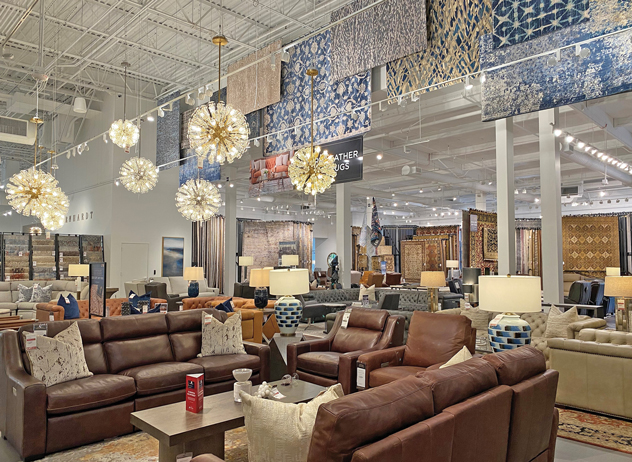 MATHIS HOME: Mathis Home in Irvine, California,
hangs rugs vertically from the ceiling in a layered fashion to
create a dramatic statement for their rug department.
MATHIS HOME: Mathis Home in Irvine, California,
hangs rugs vertically from the ceiling in a layered fashion to
create a dramatic statement for their rug department.
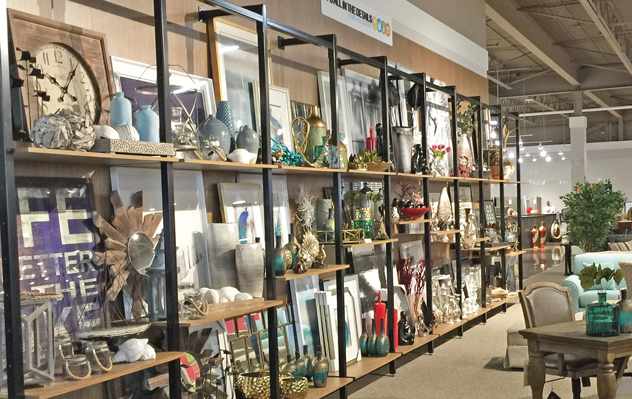 TEPPERMAN’S: Tepperman’s in Toronto, Canada, uses
a variety of accessory shelving displays to spice up their stores
and make them more interesting places to shop.
TEPPERMAN’S: Tepperman’s in Toronto, Canada, uses
a variety of accessory shelving displays to spice up their stores
and make them more interesting places to shop.
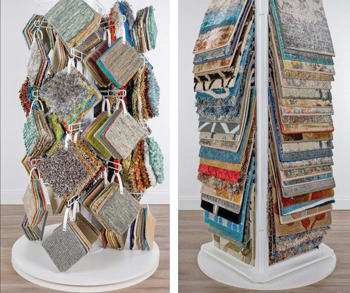 SMALLER RUG DISPLAYS: If you do not have room for
a large rug rack, there are now smaller rug display options from
vendors that allow you to still showcase rugs effectively in your
store.
SMALLER RUG DISPLAYS: If you do not have room for
a large rug rack, there are now smaller rug display options from
vendors that allow you to still showcase rugs effectively in your
store.